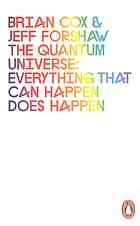
The Quantum Universe
(And Why Anything That Can Happen, Does)
فرمت کتاب
ebook
تاریخ انتشار
2012
نویسنده
Helene Dujardinنویسنده
Tony Gemignaniنویسنده
Helene Dujardinنویسنده
Tony Gemignaniنویسنده
Jeff Forshawناشر
Hachette Booksشابک
9780306820601
کتاب های مرتبط
- اطلاعات
- نقد و بررسی
- دیدگاه کاربران
نقد و بررسی

March 5, 2012
In their newest, the University of Manchester physics team that produced Why Does E=mc2? aims to make quantum theoryâ"perhaps the prime example of the infinitely esoteric becoming the profoundly useful"âunderstandable for a general audience, explaining not only what it is and how it works, but why it is important. Beginning with a brief scientific history that will be familiar to anyone who's completed college physics (but accessible to those who have not), Cox and Forshaw review Newton's laws and the discoveries of Becquerel, Rutherford, Bohr, and Heisenberg before turning to their explanation of particles and waves, as inspired by Richard Feynman, a Nobel Prize-winner described by his friend Freeman Dyson as simultaneously "all genius, all buffoon." The authors also go on to explain the origin of the periodic table, strong and weak nuclear forces, "Why We Don't Fall Through the Floor," and myriad other interesting topics. Though Cox and Forshaw state that their goal is to "demystify quantum theory," readers will nevertheless be confronted with plenty of equations and graphs rather than anecdotes and photos. Illus.

January 15, 2012
Quantum physics describes how everything (not just subatomic particles) works, but even experts agree that no one truly understands it. There is no shortage of popular introductions, but curious readers will not regret choosing this meticulous account by British physicists Cox and Forshaw (Why Does E=mc2? (And Why Should We Care?), 2009). A particle can also be a wave of pure energy, and it can be anywhere in the universe at the same time. An electron moves from one orbit of an atom to another instantly, but one can never locate it precisely. Space cannot be empty; matter constantly appears and vanishes. If quantum laws do not forbid something from happening, it will eventually happen. These are facts; experiments confirm them. Writers often explain these in relentlessly nontechnical language that converts them into a magic show, but Cox and Forshaw will have none of this. Using ingenious pedagogical examples, they demonstrate that weird quantum phenomena make perfect sense. Thus, they convert a particle/wave to a clock whose time indicates the wave's phase and whose hands turn counter-clockwise as the particle/wave moves; the square of the hand's length represents the probability of finding it in a particular spot. By following this analogy, they insist, formerly mysterious concepts such as wave-particle duality and the uncertainty principle follow naturally. While the authors show real imagination, they are dealing with profoundly challenging subjects, and readers who do not pay close attention will find themselves reduced to enjoying the traditional magic show. An ambitious explanation of the vast quantum universe aimed at readers willing to work.
COPYRIGHT(2012) Kirkus Reviews, ALL RIGHTS RESERVED.

























دیدگاه کاربران